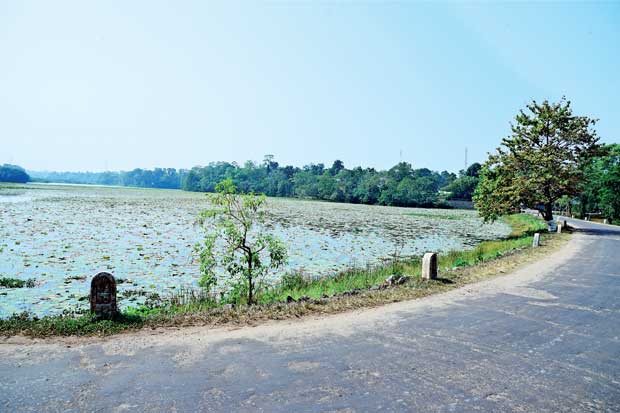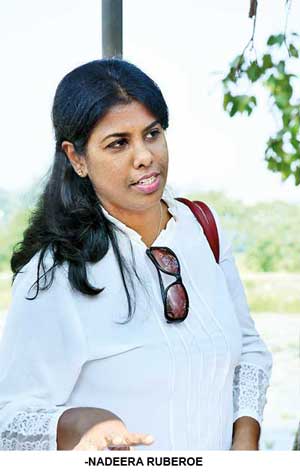Reply To:
Name - Reply Comment
Last Updated : 2024-04-19 14:00:00

World Wetland’s Day is celebrated annually on 2 February. The theme for 2018 World Wetlands Day is ‘Wetlands for a sustainable Urban Future’.
Wetland ecosystem is the most precious gift given to us by nature and possessed by us from the time of early civilization. Rapid urbanization, dumping waste and filling wetlands for commercial use are few of the critical issues threatening this nature’s gift to us. These unhealthy human  activities have put this precious ecosystem in danger. Humans driven by money and power refuse to see the connection between human well-being and the ecosystems. Therefore, conservation and proper management of these valuable wetlands are essential.
activities have put this precious ecosystem in danger. Humans driven by money and power refuse to see the connection between human well-being and the ecosystems. Therefore, conservation and proper management of these valuable wetlands are essential.
The RAMSAR Convention states, “Wetlands are land areas that are saturated or flooded with water either permanently or seasonally. Inland wetlands include marshes, ponds, lakes, fens, rivers, floodplains, and swamps. Coastal wetlands include saltwater marshes, estuaries, mangroves, lagoons and even coral reef. Fish ponds, rice paddies, and salt pans are human-made wetlands. Wetlands range in size from less than a single hectare to the Pantanal in Brazil, Bolivia and Paraguay, which covers an area three times the size of Ireland.”
Peatland, a form of wetland, prevents and reduces the impact made by floods. Peatland does this by absorbing huge volumes of water. It acts like a giant sponge, absorbing water during a flood and releases water throughout the year little by little saving the human cultivation, plants as well as animals. Muthurajawela is a Peatland in Sri Lanka. Wetlands take the form of a massive interconnected net, thus damaging a single wetland will affect all the other wetlands in the network. Tanks, canals, reservoirs and ponds are also considered wetlands. Approximately 15% of land in Sri Lanka consists of natural and man-made internal wetlands.
“Colombo has a series of interconnected wetlands, referred to as Colombo Wetland Complex which includes Beddegana, Thalawathugoda (Diyasaru Park) Kimbulawela, Madiwela, Kolonnawa, Crow Island, Thalangama Tank, and Beira Lake. This wetland complex expands to an area of approximately 4700 acres. As much as 90% of the wetlands contribute to urban food supplies through the production of rice, vegetables, dairy, poultry products plus fishing and native plants. Much of these plants are used in the practice of traditional medicine.
The Colombo wetlands play an important role in mitigating floods (with a capacity to store enough water to fill 27,000 Olympic - size swimming pools) while also helping to reduce extreme temperature across at least half of urban Colombo through evaporating and cooling. In addition, most of the wetland areas improve quality of the air by trapping and removing airborne pollutants, thus helping to reduce various cardiopulmonary and respiratory diseases.
In some areas of the Colombo metropolitan region, as much as 60% of the wetland area has been lost since the 1980’s. The current overall rate of loss through infilling and indiscriminate dumping of solid waste is estimated at 1.2% per year. Unless this trend is reversed, the wetland area will decline by 1/3 over the next two decades.
The quality of water is considered to be poor or very poor in about 2/3 of the wetlands, primarily due to untreated domestic waste water. The situation has been critical for the past five years. This has threatened the ecological health of wetlands. This situation has been made worse by routine dredging. The drainage of wetlands has made them more susceptible to a variety of invasive plant species.
Sri Lanka became a member of RAMSAR Convention in 1990. According to the RAMSAR website it is an “Intergovernmental treaty that provides the framework for national action and international cooperation for the conservation and wise use of wetlands and their resources,”. Sri Lanka has recently nominated “Colombo’s Wetlands” to be included in the RAMSAR Convention’s new programme for wetland city Accreditation. This programme aims to promote conservation and the wise use of wetlands in and around urban areas, with sustainable socio - economic benefits for the local people. The scheme encourages cities that are close to wetlands- especially those holding international importance- to increase public awareness of the value of these ecosystems in municipal planning and decision making.
Sri Lanka has submitted an application for this through the Department of Wildlife Conservation (DWLC)” IWMI says. Several community representatives who depend on the resources of the Thalangama tank clarified details relating to the history, threats faced, advantages and what should be done to protect the tank .
“The Thalangama Tank dates back to the time of King Parakramabhahu VI. Archeological evidence of an old wier has revealed that the tank was built during ancient times. This discovery was made during the construction of a new bund recently. Thalangama Tank provides water for their paddy fields, the villagers and the neighbouring community. The tank was historically known as the “Thadaaga Graama” at the time of Parakramabhahu the VI. And the tank was used to bathe elephants in the Kotte palace and to hold the traditional “water-cutting ceremony” in an adjacent Devala (Shrine). With the demolishing of the Kotte Kingdom, the tank and its importance was also forgotten. Many acres of paddy fields were neglected. Now, the major issue is water management. The floods that occurred in 1989 was due to lack of vision. Even the parliament complex was flooded. All that was a result of filling the ‘Lake Drive’ sans a proper plan’ a representative from the community said.
In case this type of floods repeat, we should be ready with solutions
Thalangama Tank is providing livelihood to 175 farmers, nurturing more than 200 acres of rice paddy and contributing to the urban food supply. It is home to 70 species of birds, 30 species of other animals including dragonflies, fishing cat, Purple-faced Leaf Monkey and moose deer. Covering about 35 acres, Thalangama Tank and its surrounding wetlands are ‘Environment Protection Areas’ named by the Central Environment Authority (CEA) under the National Environment Act of 1980.

The President of Parakum Farmers’ Association said they are facing a major threat of destruction due to the ill practices of the neighbouring community of the lake. They are disposing untreated waste water into the tank. The second threat comes from the garbage dropped along the road surrounding the tank by impertinent bypassers. The villagers are always on alert since protecting the tank is critical for their livelihoods. He said the members of three farmers’ associations are using the water from the tank for their paddy cultivation. “Outsiders come to bathe in the tank, but we don’t even put our feet in the water. Once it was revealed that the water in the tank was contaminated with feces. Rich householders in the boundary of the tank are sending all their waste water into the tank.
“Pond Apple (Wel aththa) is posing another threat to this valuable ecosystem since this invasive plant has been growing on a large patch (eight and half acres) in the middle of the tank. This issue was later controlled. Specialists find it difficult to solve the ‘Pond Apple’ issue since a number of animal species are living on these trees. Pond apple is a critical threat to all the wetland ecosystems.This tank is widely used to control flooding in the parliament area. Massive floods occurred in May and November in 2010. In case this type of floods repeat, we should be ready with solutions. Controlling floods wisely using these wetlands will reduce their impact on Colombo and suburb areas,” Nadeera Ruberoe, a Wetlands Ecologist said.
 “Continuing business as usual will cost water users, fisheries, the tourism industry and Government budgets almost LKR 35 billion over the next 25 years,” said Lucy Emerton, an economist attached to Environment Management Group, SOAS University of London.
“Continuing business as usual will cost water users, fisheries, the tourism industry and Government budgets almost LKR 35 billion over the next 25 years,” said Lucy Emerton, an economist attached to Environment Management Group, SOAS University of London.
“The Key challenge to the wetlands is shifting the process of development plans in wetlands. Wetlands actually save people a great deal of money as well as control floods. We have to invest on these wetlands. Investing on wetlands conservation adds substantial value to the urban economy and avoids costly losses and damages. Continuing ‘business as usual’ will cost water users, fisheries, the tourism industry and Government budgets almost LKR 35 billion over the next 25 years. Wetlands generate economic services, facilities and amenities worth around Rs 723,000 ha/ year. The value of wetlands has been assessed for the year 2018 as follows :
Flood control
- LKR 1,485 million a year
Water purification
- LKR 521 million a year
Recreation
- LKR - 16 million a year
Energy supplies
- LKR- 24 million a year
Fisheries productivity
- LKR- 80 million a year
Support to agriculture
- LKR- 93 million a year
Total - LKR 2219
million a year
Flood retention, nurturing rice paddies and waste water purification are among the major services provided by wetlands to humans and the environment. We can’t value the role played by wetlands to control floods.
She also mentioned that Muthurajawela is a multipurpose natural asset, which is widely useful to the production of paddy and fish. Answering a question regarding the dumping of waste into Muthurajawela, she said the waste is leeching into the water of wetland polluting surrounding ecosystems as well as the Negombo lagoon.
“People think the wetland is a smelly, dirty, unhealthy and unproductive land. What they think of is to build shopping malls and houses in lands like these. City dwellers need environments like these to unwind too. They can visit these beautiful wetlands with their children and relax. That is vital to city dwellers’ mental well-being,” she added.
According to the IWMI, Diyasaru Park-formerly known as the Thalawathugoda wetland covering 60 acres -has been developed by the Sri Lanka Land Reclamation and Development Corporation (SLLRDC) into an urban wetland. Together with the Parliament Lake, the park has been designated as a wildlife sanctuary (Sri Jayawardenepura Sanctuary) by the DWLC under the Fauna and Flora Protection Ordinance of 1937. This park is home to more than 28 species of dargonflies, 28 species of reptiles, 7 species of mammals (including the fishing cat and otter) and more than 80 species of birds and more than 40 species of butterflies. The park serves the environment as a flood retention zone.
International Water Management Institute (IWMI) arranged a field visit for journalists to visit the Thalawathugoda Tank and Diyasaru Park. They were accompanied by environment experts who provided them with information regarding threats, challenges and the importance of conserving wetlands.


Add comment
Comments will be edited (grammar, spelling and slang) and authorized at the discretion of Daily Mirror online. The website also has the right not to publish selected comments.
Reply To:
Name - Reply Comment
On March 26, a couple arriving from Thailand was arrested with 88 live animal
According to villagers from Naula-Moragolla out of 105 families 80 can afford
Is the situation in Sri Lanka so grim that locals harbour hope that they coul
A recent post on social media revealed that three purple-faced langurs near t